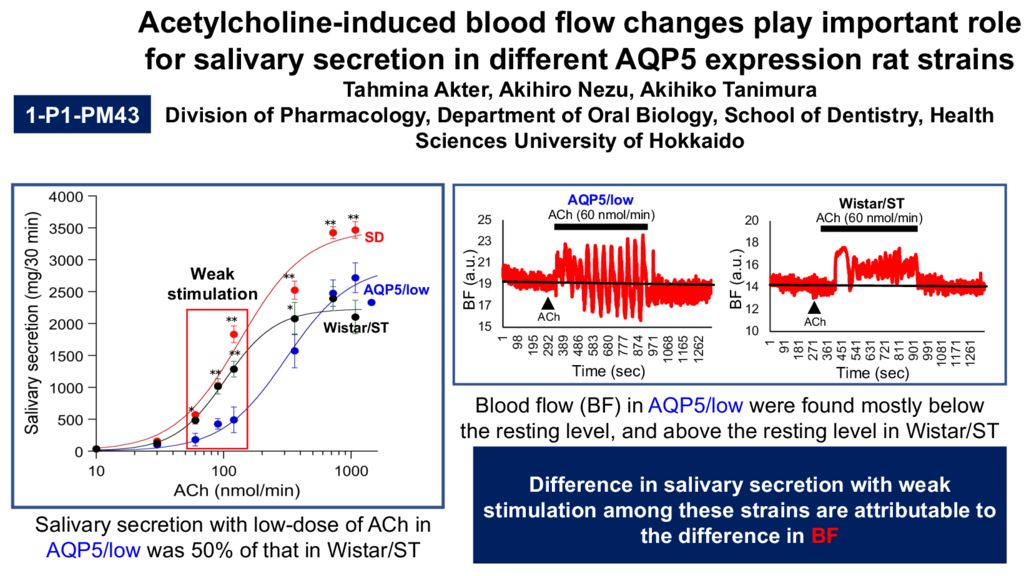Author: 〇Akter Tahmina、Nezu Akihiro、Tanimura Akihiko
Affiliation: 北医療大・歯・薬理
Abstract: Purpose: Aquaporin 5 (AQP5) plays an important role for the transcellular fluid secretion in salivary gland cells. The AQP5 low expression rat (AQP5/low), established from Sprague-Dawley (SD) strain, has been used to examine the role of AQP5 in salivary secretions. In this study, we compared acetylcholine (ACh)-induced salivary secretion, blood flow (BF), and Ca2+ response in submandibular gland (SMG) in AQP5/low, SD and Wistar/ST rats.Materials & Methods: The expression of AQP5, TMEM16A, and NKCC1, angiotensin II (Ang II) receptor (AT1R), and angiotensin-converting enzyme (ACE) in SMG were analyzed by Western blot and RT-PCR. [Ca2+](i) in dispersed SMG cells was examined by fluorescence spectrophotometer using fura-2.Secretions of whole saliva were examined by the cotton ball method, and the real-time monitoring of BF in SMG by the laser speckle BF imager were performed under anesthesia with continuous infusion of ACh.Results & Conclusions: The maximum secretions with high-dose of ACh (720-1440 nmol/min) in AQP5/low and Wistar/ST were ~70% of that in SD. The expressions of AQP5 in Wistar/ST were same level as that in AQP5/low, and much lower than that in SD, suggesting that the expression level of AQP5 determine the maximum rate of salivary secretions. Interestingly, however, the salivary secretions with low-dose of ACh (60-120 nmol/min) in Wistar/ST was two times higher than that of AQP5/low, and was comparable to that in SD. The ED50 values for ACh-induced salivary secretion in AQP5/low, Wistar/ST, and SD were 309, 102, and 134 nmol/min, respectively. These results suggest that ACh sensitivity in salivary secretion does not correlate with expression levels of AQP5. Monitoring of BF in SMG demonstrated that low-dose of ACh induced oscillatory changes in BF in all strains. The BF oscillations in AQP5/low were found mostly below the resting level, whereas that in Wistar/ST were found above the resting level. We also found that the expression of AT1R and ACE in AQP5/low were significantly higher than that in Wistar/ST. These results suggest that ACh decreased BF through the Ang II-mediated vasoconstriction in AQP5/low, which caused a decrease in salivary secretion. On the other hand, EC50 values for ACh-induced [Ca2+](i rise in these strains were almost same (~0.8 μM). Gene expressions of TMEM16A and NKCC1 of these strains were also same. These results indicate that the differences in salivary secretion with weak ACh-stimulation among these strains are attributable to the difference in BF rather than AQP5 expression level.
[1-P1-PM43] AQP5発現量の異なるラットにおいてアセチルコリンによる血流変化は唾液分泌に重要な役割を果たす
 薬理学
薬理学+1
 メールで問い合わせ
メールで問い合わせ

コメント